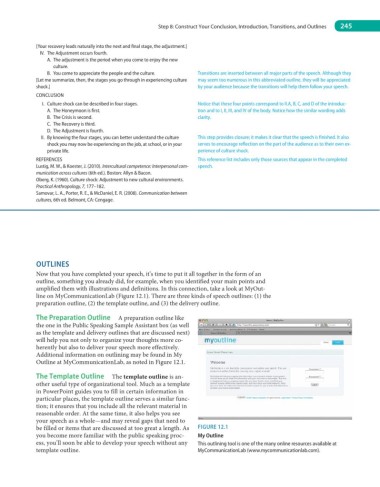Page 266 - Essentials of Human Communication
P. 266
Step 8: Construct Your Conclusion, Introduction, Transitions, and Outlines 245
[Your recovery leads naturally into the next and final stage, the adjustment.]
IV. The Adjustment occurs fourth.
A. The adjustment is the period when you come to enjoy the new
culture.
B. You come to appreciate the people and the culture. Transitions are inserted between all major parts of the speech. Although they
[Let me summarize, then, the stages you go through in experiencing culture may seem too numerous in this abbreviated outline, they will be appreciated
shock.] by your audience because the transitions will help them follow your speech.
CONCLUSION
I. Culture shock can be described in four stages. Notice that these four points correspond to II.A, B, C, and D of the introduc-
A. The Honeymoon is first. tion and to I, II, III, and IV of the body. Notice how the similar wording adds
B. The Crisis is second. clarity.
C. The Recovery is third.
D. The Adjustment is fourth.
II. By knowing the four stages, you can better understand the culture This step provides closure; it makes it clear that the speech is finished. It also
shock you may now be experiencing on the job, at school, or in your serves to encourage reflection on the part of the audience as to their own ex-
private life. perience of culture shock.
REFERENCES This reference list includes only those sources that appear in the completed
Lustig, M. W., & Koester, J. (2010). Intercultural competence: Interpersonal com- speech.
munication across cultures (6th ed.). Boston: Allyn & Bacon.
Oberg, K. (1960). Culture shock: Adjustment to new cultural environments.
Practical Anthropology, 7, 177–182.
Samovar, L. A., Porter, R. E., & McDaniel, E. R. (2008). Communication between
cultures, 6th ed. Belmont, CA: Cengage.
Outlines
Now that you have completed your speech, it’s time to put it all together in the form of an
outline, something you already did, for example, when you identified your main points and
amplified them with illustrations and definitions. In this connection, take a look at MyOut-
line on MyCommunicationLab (Figure 12.1). There are three kinds of speech outlines: (1) the
preparation outline, (2) the template outline, and (3) the delivery outline.
the preparation Outline A preparation outline like
the one in the Public Speaking Sample Assistant box (as well
as the template and delivery outlines that are discussed next)
will help you not only to organize your thoughts more co-
herently but also to deliver your speech more effectively.
Additional information on outlining may be found in My
Outline at MyCommunicationLab, as noted in Figure 12.1.
the template Outline The template outline is an-
other useful type of organizational tool. Much as a template
in PowerPoint guides you to fill in certain information in
particular places, the template outline serves a similar func-
tion; it ensures that you include all the relevant material in
reasonable order. At the same time, it also helps you see
your speech as a whole—and may reveal gaps that need to
be filled or items that are discussed at too great a length. As FiGure 12.1
you become more familiar with the public speaking proc- My Outline
ess, you’ll soon be able to develop your speech without any This outlining tool is one of the many online resources available at
template outline. MyCommunicationLab (www.mycommunicationlab.com).

